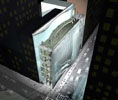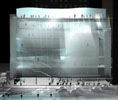| |
Design Concept
By SHoP Architects
When the directors of the Museum of Sex first spoke with us about building a new museum on Fifth Avenue in New York City, they had a very clear and original concept of the content of the intended exhibitions, but asked us what a museum of sex should look like. We began by asking if there is a relationship between form and performance that could aid in the design of a space for the display of human sexuality. The diagrams we developed were to be variable rather than relying on bifurcating models such as male - female, straight - gay, or spectator - participant. We searched for a supple and ambiguous correlation between desires and an architecture that could allow for a reevaluation of ideas and concepts about the body, sexuality, and space. What emerged was a new understanding of the boundaries between a cultural institution and an economic engine, display and consumption, program and event, and thought and process. The extremely narrow floor plan of the site suggested the use of a layered organizational device, and the generative concepts of organic form, tactile expression, and exposure and concealment led to thinking of this device as "skin." This skin is made up of layered surfaces with specific functions. The particular placement and curvature of walls are designed for optimal performance as dictated by program requirements such as circulation, exhibition, flexibility, or lighting. The innermost wall conceals necessary building infrastructure within a continuous sculptural form. Visitors are oriented in a rooftop theater that opens onto a sculpture garden. The galleries below are reached by descending through the thickness of the interior and exterior walls. The facade is a play of several translucent layers, sometimes fusing in a readable thickness, sometimes peeling apart to allow vertical movement, light filtration or to house displays. As the undulating topography responds to the forces implied by the program, structure, zoning resolution, and building codes, the section is revealed on the front elevation, where the layers slice through the clear glass facade and become monumental banner signs at the entrance. Thus the cross section of the skin is not limited to an enclosing envelope, but instead encompasses the entire thickness of the space. This shift in the understanding of the enclosure and facade allows a dissolution of the boundary between the museum container and the urban fabric. The museum visitor must reevaluate their place in the city when the thickened membrane of the space is both internal and external, while their body is suspended in a new type of urban space. The public has a new understanding of the museum - not as a repository of collected objects, but as a cultural institution dedicated to our daily thoughts and events. This ambient blending of trajectories, space, and form, collects and redirects forces to provide a spatial solution that is open, gestural, revealing, and sexy.
| |











